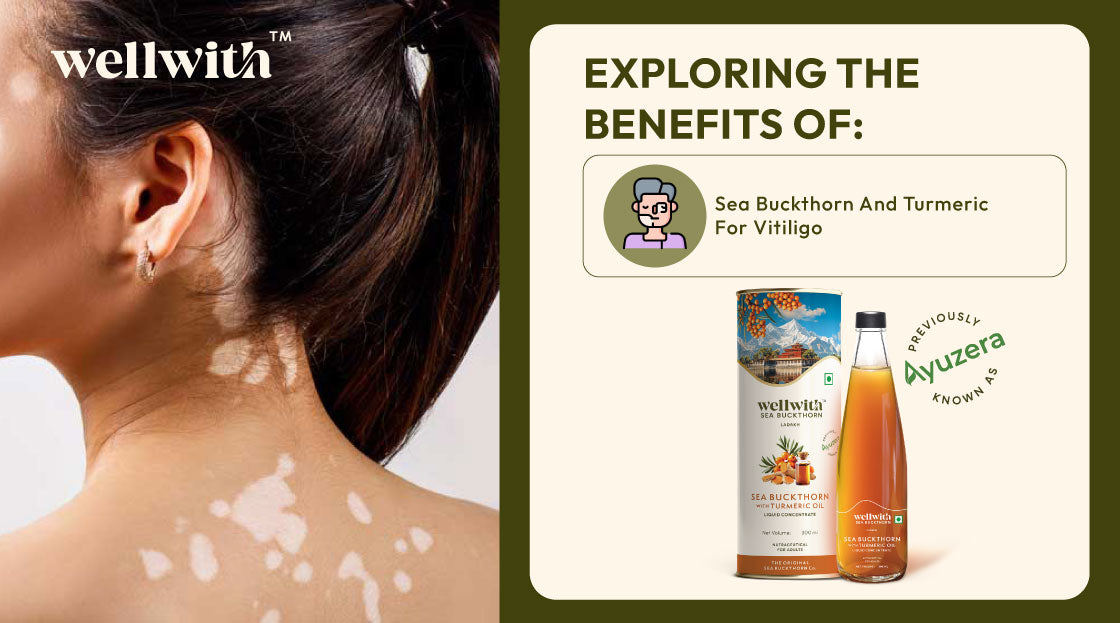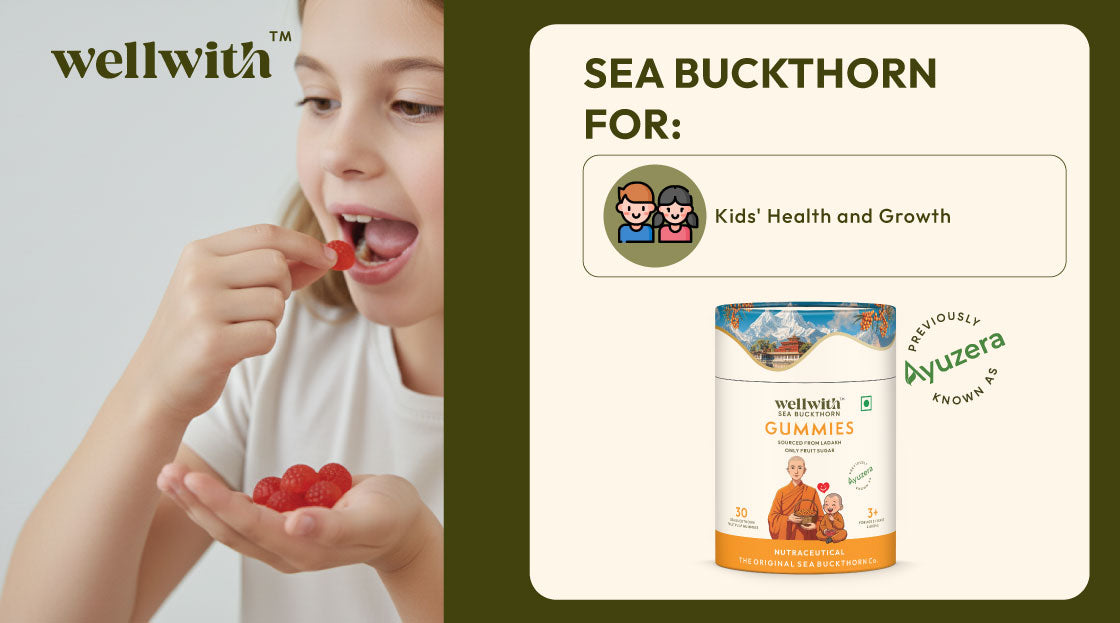Living with vitiligo can sometimes feel disturbing and challenging, but nature has its own gentle ways of lending a hand that make things easier. Among its treasures are two powerful helpers, that is, Sea Buckthorn and Turmeric.
These natural ingredients have been loved for centuries, not just for their vibrant colors, but also for the nutrients and bioactives that are present in sea buckthorn and turmeric, and the benefits they bring to your skin. Together, they may offer a gentle calming effect and a touch of brightness to your skincare journey.
Therefore, let’s explore the benefits of sea buckthorn and turmeric for vitiligo, as well as their key ingredients that help manage this condition.
Benefits Of Sea Buckthorn for Vitiligo
Sea buckthorn is a small, orange berry rich in powerful nutritional ingredients, particularly beneficial for skin health.
-
Sea buckthorn is rich in vitamins A, B, and C, Omega fatty acids, essential amino acids, and polysaccharides.
-
Ingredients, like omega fatty acids, antioxidants, and flavonoids, work together to protect the skin, calm inflammation, and support skin regeneration.
-
If you are suffering from vitiligo, it is essential to take special care of your skin, as vitiligo-affected areas can be more sensitive and prone to dryness.
-
Sea buckthorn is a flowering plant that helps to reduce oxidative stress, soothes irritated skin, and may help slow down pigment loss.
Benefits Of Turmeric for Vitiligo
Not only for its flavoring of our meals but also for its amazing therapeutic benefits, turmeric is sometimes referred to as the golden spice. The active ingredients of turmeric, curcuminoids, are at the center of its healing ability; curcumin is the most important among these.
-
Natural anti-inflammatory and anti-oxidant curcumin greatly contributes to the preservation and repair of the skin.
-
The chemical aids in neutralizing hazardous radicals under circumstances like vitiligo, when melanocytes are destroyed and patches of skin lose their natural pigment.
-
Inflammatory response suppression in the skin using radicals. This slows down additional pigment cell damage as well as encourages a healthier environment for skin healing.
-
Furthermore, turmeric's antibacterial properties might shield vulnerable and depigmented skin from secondary infections, which are frequently a worry for people with vitiligo.
-
Turmeric improves general skin health and boosts resilience when taken in conjunction with a nutrient-rich diet and adequate dermatological care.
Although turmeric is not a treatment for vitiligo, its regular application, whether added to foods, consumed as supplements, or utilized in precisely prepared topical paste, might assist in treating the condition. In conventional treatments to promote repigmentation in some people, turmeric has also been combined with other healing compounds like mustard oil.
Sea Buckthorn And Turmeric: A Natural Combination For Skin Health
When it comes to your skin, sea buckthorn and turmeric can be an incredible combination for skin health because both are plant-based ingredients that are packed with vitamins, antioxidants, and skin-healing properties that work like natural magic on your skin and give you a nourishing, healthy, and glowing touch.
Together, they work in harmony to nourish deeply, comfort sensitive areas, balance the skin’s natural barrier, and promote a radiant, youthful glow. Therefore, these two ingredients create a melodious blend that not only deeply nourishes and calms sensitive skin areas but also strengthens the skin’s natural barrier.
Conclusion
Sea Buckthorn pulp with turmeric oil has been seen as a promising natural supplement in reducing vitiligo symptoms. High in antioxidants, vitamins, anti-inflammatory compounds, and other nutritional ingredients infused in SB turmeric oil support you in enhancing melanocytes, melanin, and address other concerns that may cause vertigo.
Clinical studies and traditional use both highlight turmeric's ability to reduce lesion size and support repigmentation, while the purest quality of sea buckthorn nourishes and soothes sensitive skin, promoting skin regeneration and maintaining the skin’s glow.
FAQs
1. Can Sea Buckthorn help in repigmentation for vitiligo?
Yes, Sea Buckthorn for Vitiligo can be helpful in repigmentation for vitiligo, especially because of its ability to protect and nourish your skin, and it is packed with antioxidants and vitamins that help in reducing oxidative stress.
2. How does turmeric support vitiligo-affected skin?
Turmeric for Vitiligo supports the skin with its active compound called curcumin because it has anti-inflammatory and antioxidant properties that help to reduce skin inflammation and protect your skin from damage, which is a major factor in vitiligo.
3. Can I use Sea Buckthorn pulp with turmeric oil for vitiligo?
Yes, you can use WellWith Sea Buckthorn pulp with turmeric oil for vitiligo, and many natural treatment approaches actually combine ingredients with complementary benefits. WellWith SB turmeric oil is rich in antioxidants that nourish and protect the skin with its active compound curcumin, known to mollify irritated skin.
4. Are there any side effects of using Sea Buckthorn for vitiligo?
Sea buckthorn is generally safe for use, but like any natural product, it may have some side effects, especially when it is used for vitiligo. Oral use of sea buckthorn supplements is also usually safe in normal doses, but some people have experienced digestive symptoms or joint pain during trials.




